| A confession is in order. This card is a total cop out. The original idea, one that I have not abandoned and tends to nag, was to describe a war between snails and slugs over a series of some six or so pages. I have already finished much work on that project. Various types of trebuchets (siege machine) in paper were worked out with salt ammunition but the backgrounds were left undone. A page depicting slugs torturing a snail was worked out. This page here was one of four variations of a peaceful snail settlement that would be followed by a peaceful slug settlement but with handwritten signs in each describing animosity or some kind of feud. I had a page with snail ram-rods that would require a slug castle. I devised weapons all having to do with salt and salt traps, a page with beer traps arranged as land mines with signs advertising "free food" was devised. Another page showed snails and slugs jousting. The final page would be slugs operating an escargot stand. I dithered this way as three important birthdays loomed and time was quickly running out. Finally there was no time left. It occurred to me in a moment of panic that the recipients don't care the slightest about what ideas I have cooking. All that they appreciate is the card in hand, the one that they get through the mail addressed directly to them, and that can be anything, even a lame one page pop-up. So I adapted the peaceful snail settlement to omit any mention of slugs. Although I did consider a "no slugs allowed" sign. Anyway, these three cards turned out to be something of a marathon. I worked all night to 4:00 in the morning until I became unsteadywith the X-ACTO knife right at the point of the most vital final cuts. So I went to bed with the three cards unfinished and really behind the 8-ball. The next morning I finished them which took another three hours, photographed one, and ran them off to the post office, which thankfully is just a few blocks away. I didn't bother with fashioning envelopes because I would have to make three and it was more important to mail them than to fuss around with a decorative envelope in addition to the mailer. I'm glad they're gone. But I am still thinking about a snail and slug war and how cool that would be. It is just too funny an idea to let go. The trebuchet is particularly hilarious with its packets of NaCl stacked up and ordinary salt shakers on the side. |
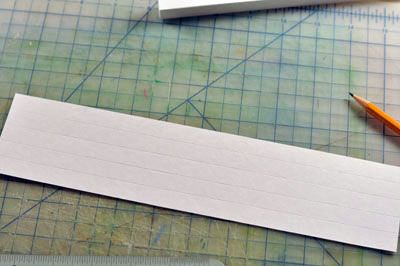 |
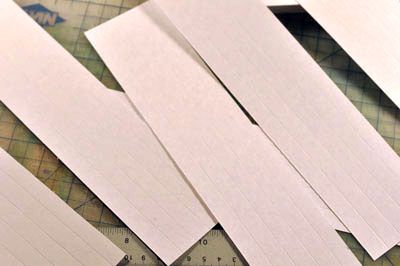 |
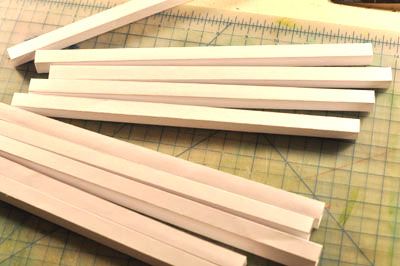 |
| A tree placed on the central fold flips up. It is the single mechanism on the card. All the snails and the signs are attached to the tree on either the right or the left side of the fold. Another layer is created in order to disguise the connection between tree and snails (and signs). It could be devised as a single layer, as a table that gets lifted when the tree is lifted. All the slots for the posts must then be measured and cut at once and they must align perfectly with the posts that support the content (the snails and the signs). Should the posts be fitted through slots first then attached to the base, or attached to the base first and then fitted through slots later? Perhaps cuts in the top layer could be made then the cuts used to locate the positions on the base. It is all so confusing. To make the alignment easier, I decided to use these square tubes instead. The entire length of the tube would not be needed, but rather just segments would work as long as the segments were placed as if they were full tubes. This would facilitate folding by presenting less resistance. Clever, eh? Tube segments are aligned at the same angles as the tree, which was arbitrary to begin with. . They can be segments because they' will be attached to the tree and not lifting themselves up as separate mechanisms, in which case the full length of the tube would be necessary. The tubes will determine the height of the new layer. A matrix is to be built upon the square tube segments and then filled out leaves to form a new layer. That was the idea to get around the mathematics and the precision required of placing slots through a solid table layer, and finding the anchor placements for the posts that will stand up content. The choice turned out to be a massive pain in the ass. But the result is kind of cool. |
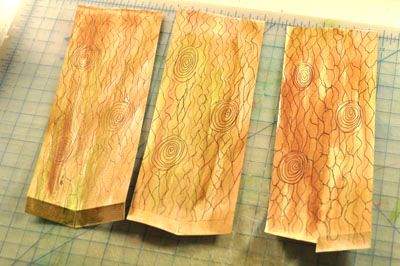 |
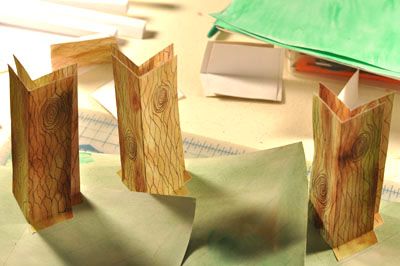 |
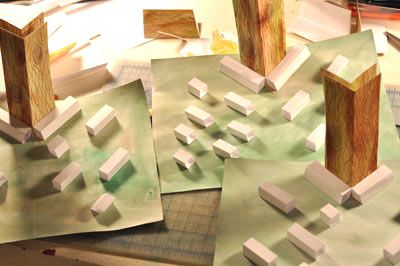 |
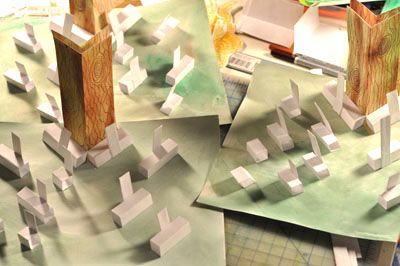 |
| The matrix that connects the square tubes to the tree is random. There is a right side and a left side. Understand, it needn't be this way. It could be a single layer for the right side and the left, or it could be a single layer with a crease in it directly above the central fold, but then all those upright would have to be dealt with, attached to the bottom and fitted through slots. This avoids that, but at what cost? |
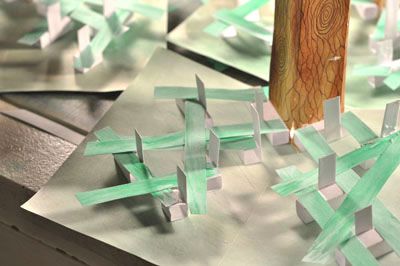 |
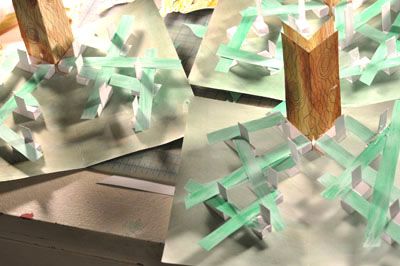 |
| This is 1/3 the number of leaves that was necessary to cover the matrix and to form a new layer that disguises the connection between the snails and the tree. |
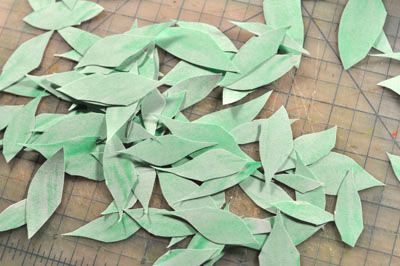 |
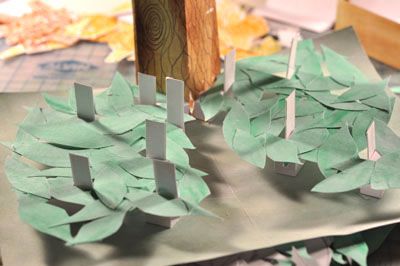 |
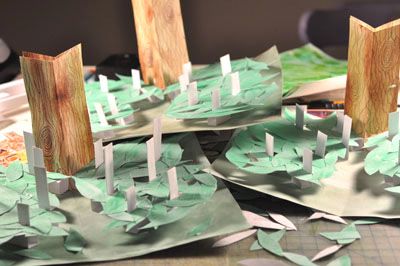 |
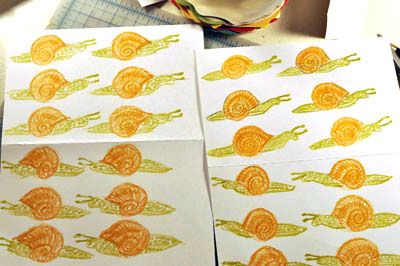 |
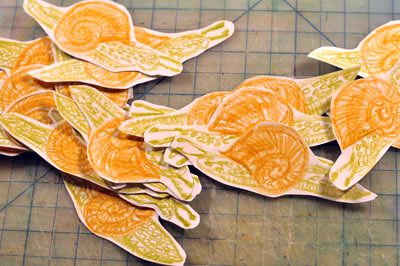 |
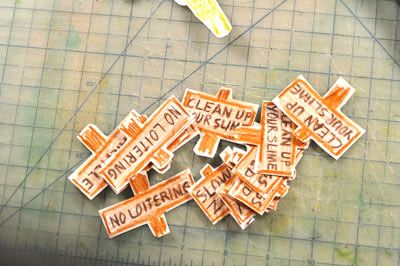 |
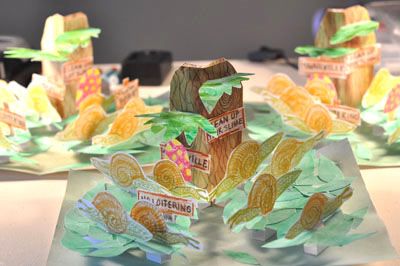 |
Showing posts with label card. Show all posts
Showing posts with label card. Show all posts
snail town pop-up card construction
pop-up doors

Now for the words. For whatever it's worth.
This basic mechanism is a page hinged to the right side of the card's central fold. The page is flipped to the left side of the card and is forced to slide under strips that keep it on the left side. The distance of movement the sliding card makes is double the distance of the hinge from the central fold.
When the card is opened flat on the table, the hinge for the new page is positioned 1/4" to the right of the fold when the card is opened, which translates to 1/4" elevation when the card is half opened, and 1/4" to the left of the fold when the card is closed, and that total movement translates to 1/2 ", which is the distance the hinged sliding page travels by being dragged as the card is opened. This is apparent in the photographs.
For the sake of understanding pop-up delight, it's essential to understand this basic thing: 1/4" distance of the first long hinge from the central fold creates 1/2" movement of the new page by the action of opening the card and forcing the hinge attached to the sliding page to move that same distnce. That is, when the card is opened, the long hinge attaching the sliding page moves from the left side of the central fold up and over to the right side of the central fold. when the card is closed that movement is reversed. The hinge travels from the left side of the fold up and over to the right side of the fold, back to the original position of when it was glued That movement can be used to transfer movement to another hinge, to a door attached to the sliding page, and with a slot, to flip the door 180˚, from shut to open, which is amusingly dramatic.
Another flap is hinged to the sliding page. That new flap is the door. The door is fitted through a slot so the hinge flips the door as the hinge slides underneath the slot. Flip, flip, flip. It's funny. See, when the card is flat on the table and half way opened in the 90˚ position then the sliding page attached to the right side of the card has traveled half its distance. That's how you discover the placement of the far left brace, the position of the door, and the position of the second brace that creates the slot. The sliding page holding the hinge has the full 1/2 " movements that drags the door with it, but the slot is restricting the movement of the door. The slot forms a line of pivot upon which the door is forced to flip. It's funny! But it all depends on the page sliding through the slot. If it snags, well, that's a problem that must be fixed.
This practice card stock is not very sturdy. It must be reinforced. The sliding page is actually shoving the thing into action and the slot is forcing the door to move open and closed. Therefore it must slide easily and be sturdy enough to shove without bending. Make it so.
With me so far?
Goodie. The other thing is, this doorway has two doors. It would be easier to have just one door, but I'm looking for drama here because it would be funnier, in my opinion, for the monkey to dramatically fling open two doors.
The second door works in harmony with the right side of the card. That is, they open vaguely parallel with each other. It would be possible to simply attach the second door to the right side of the card so that they open and close together, say with an attached strip sliding along another slot that controls the attached door in harmony with the card, and that's not a bad idea but it strikes me as inelegant. It could even be done with a string. I could also insert another mechanism at the card's central fold immediately under or above or possibly next to the doorway attached to the second door and also attached to the right side of the card that opens it, then disguise the mechanism with something artistic, like a plant, but that also strikes me as inelegant.
The thing is, I intend for a monkey to occupy the doorway with arms attached to the insides of the doors that stretch out somehow when its opened. So I think it's possible to use the present mechanism and attach the second door also to the sliding page with a sort of paper pole so the door is forced open with an opposing force then dragged shut when the card is closed. Or possibly dragged open with a complementing force and shoved closed. Or something. The pole can become the monkey's arm and the hinge from pole to door can become the monkeys hand. The monkey can be glued on top of the pole. I'm imagining. See, I don't have it all worked out yet but this is how the thing comes about.
You can probably see how two slots cut into the card could provide a way for the sliding page to disappear and for the hinge to the door appear through a slot from underneath. That would have the advantage of putting the mechanism out of sight. But doing that would make the sliding page unavailable to attach the post that becomes the monkey's arm that opens the second door. Not an insurmountable problem, and at this point still an option.
At any rate, this is one idea for the doors. There are also a few other ideas I want to try that are completely different. At some point I'll get tired of the whole thing and mail whatever I have at the time. Which is the only way really to put an end to it and clear the slate.
Page one: two humans pop-up in front of a doorway which also pops up behind them. One human says to the other, "It's scientific fact that monkeys cannot open doors." This page is simple enough it does not need to be worked out.
Page two: ↓. I just now realized this monkey needs a tail. I think. Maybe not.
Cover: probably a drawing of a monkey.

Here's the second angry monkey series.
Subscribe to:
Posts (Atom)